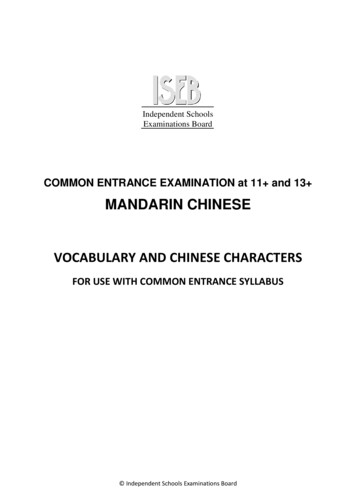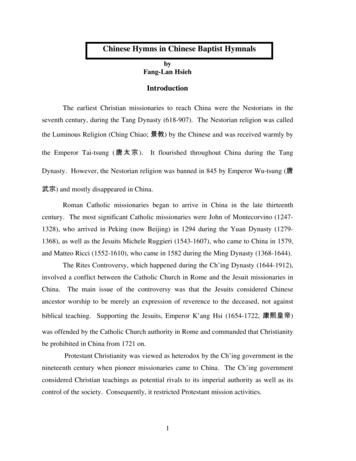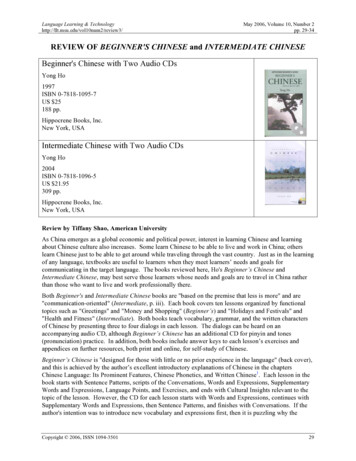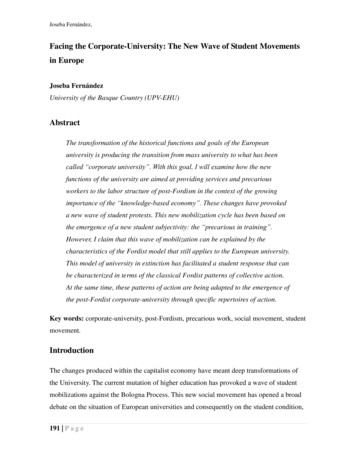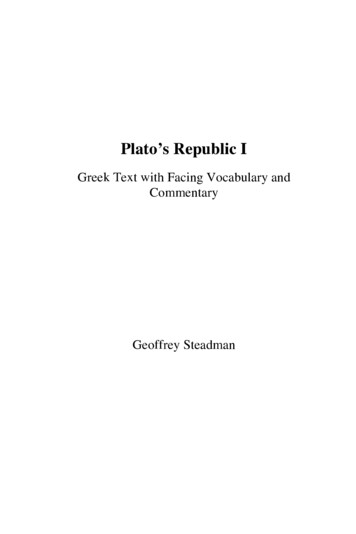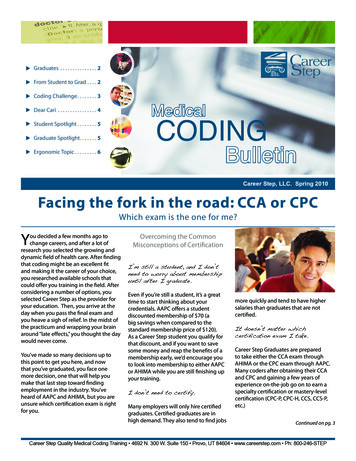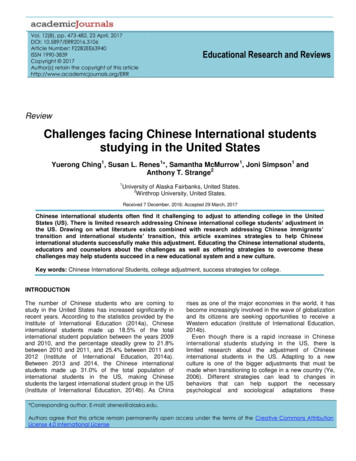
Transcription
Vol. 12(8), pp. 473-482, 23 April, 2017DOI: 10.5897/ERR2016.3106Article Number: F22B2EE63940ISSN 1990-3839Copyright 2017Author(s) retain the copyright of this nal Research and ReviewsReviewChallenges facing Chinese International studentsstudying in the United StatesYuerong Ching1, Susan L. Renes1*, Samantha McMurrow1, Joni Simpson1 andAnthony T. Strange21University of Alaska Fairbanks, United States.2Winthrop University, United States.Received 7 December, 2016; Accepted 29 March, 2017Chinese international students often find it challenging to adjust to attending college in the UnitedStates (US). There is limited research addressing Chinese international college students’ adjustment inthe US. Drawing on what literature exists combined with research addressing Chinese immigrants’transition and international students’ transition, this article examines strategies to help Chineseinternational students successfully make this adjustment. Educating the Chinese international students,educators and counselors about the challenges as well as offering strategies to overcome thesechallenges may help students succeed in a new educational system and a new culture.Key words: Chinese International Students, college adjustment, success strategies for college.INTRODUCTIONThe number of Chinese students who are coming tostudy in the United States has increased significantly inrecent years. According to the statistics provided by theInstitute of International Education (2014a), Chineseinternational students made up 18.5% of the totalinternational student population between the years 2009and 2010, and the percentage steadily grew to 21.8%between 2010 and 2011, and 25.4% between 2011 and2012 (Institute of International Education, 2014a).Between 2013 and 2014, the Chinese internationalstudents made up 31.0% of the total population ofinternational students in the US, making Chinesestudents the largest international student group in the US(Institute of International Education, 2014b). As Chinarises as one of the major economies in the world, it hasbecome increasingly involved in the wave of globalizationand its citizens are seeking opportunities to receive aWestern education (Institute of International Education,2014b).Even though there is a rapid increase in Chineseinternational students studying in the US, there islimited research about the adjustment of Chineseinternational students in the US. Adapting to a newculture is one of the bigger adjustments that must bemade when transitioning to college in a new country (Ye,2006). Different strategies can lead to changes inbehaviors that can help support the necessarypsychological and sociological adaptations these*Corresponding author. E-mail: slrenes@alaska.edu.Authors agree that this article remain permanently open access under the terms of the Creative Commons AttributionLicense 4.0 International License
474Educ. Res. Rev.students must make (Bertram et al., 2014).According to Lillyman and Bennett (2014), there arenumerous benefits for international students studyingabroad. For the Chinese international students, studyingabroad offers an exciting opportunity to mix with studentsand faculty from other countries, which may increasetheir level of confidence (Warring, 2010). In addition,students‟ views are challenged as they experiencepersonal development and become independent thinkersand agents for change (Lillyman and Bennett, 2014).Furthermore, due to the education they receive in the US,these students can become globally employable andleaders in their field when they return home (Campbell,2010).There are benefits to institutions hosting internationalstudents (Lillyman and Bennet, 2014; Perry, 2016). Forthe host institution, financial gain is one benefit. In 2013,international students contributed approximately 27billion to the US economy, an increase of 3 billionfrom the prior year (Institute of International Education,2014b). Apart from financial gain, other benefits includean increased profile among international students, whichcan improve the understanding of cross-culturalcommunication for the host institution. In addition,international students often become involved in the localChinese life and the local community. This could help theinstitution become better connected to the local Chinesecommunity. When there is a large population ofinternational students, it may internationalize the programand increase opportunities for international cooperationbetween different institutions from different countries.This is also a process of internationalization, and theinternalization of the institution is likely to improve theinternational reputation and enhance internationalcooperation (Lillyman and Bennett, 2014). HavingChinese students on campus also potentially brings anadditional ethnic, cultural and global perspective andworldview.Thisisbeneficialtotheinstitution and important to other students in theclassroom and learning environment.THE CHALLENGESThe process of cultural adjustment is viewed as astruggle for young Chinese international students in theUnited States (Flannery and Wieman, 1989; Hendricksonet al., 2011; Jung et al., 2007). International students mayexperience cultural shock, among other challenges suchas being away from families, and lack of social support,while adapting in the host country (Arasaratnam andDoerfel, 2005; Hendrickson et al., 2011; Smith andKhwaja, 2011; Spencer-Rogers and McGovern, 2002;Williams and Johnson, 2011).There is substantial research on Chinese immigrantstudents in the US but a limited number of researcharticles on international students in the US (Bennett,2008; Kim et al., 2009; Yeh, 2003; Yeh et al., 2008;Zhang and Goodson, 2011). The research on Chineseimmigrant students offers insights about the process ofcultural adjustment for the Chinese international students.According to Ye (2006), international students aredefined as a special group who live in a foreign countrypursuing an educational goal. Unlike immigrants, themajority of international students plan to go back homeafter they finish their degree.The Chinese immigrant students, especially those whohave arrived in the US recently, may have manysimilarities with the Chinese international students interms of previous cultural experience, their identity withthe Chinese culture, and language (Tsai et al., 2000).However, these two groups differ in that immigrantstudents may arrive with their family and are allowed towork in the United States. They may believe there is aneed to establish a long-term relationship with themainstream American culture, whereas internationalstudents may be curious about the culture but they do notnecessarily intend to stay in the US.Due to the similarities between Chinese internationalstudents and first generation Chinese immigrant students,the findings in the literature can, at times, be generalizedto Chinese international students (Tsai et al., 2000).Studies have been implemented to investigate thevariables that may influence the process of acculturationin Chinese immigrant students. These variables includelanguage proficiency, age, social support, family support,cultural differences, and years of stay in the host country.In the study of Chinese immigrant students, the searchhas also focused on the special characteristics of theChinese culture and the potential identity crisis betweenthe Chinese culture and American culture (Kwan andSodowsky, 1997).ADAPTATION VARIABLESAdapting to a new culture is viewed as requiring adynamic shift in personal identification (Tran, 2011). Theprocess is a dual process including cultural andpsychological change. Many international students havereported the adaption as a positive experience, thoughthe process might be challenging. The cultural adaption isperceived as a process that enhances internationalstudent‟s intercultural communication competence(Lillyman and Bennett, 2014).Based on the literature addressing both internationalstudents and Chinese immigrants, the prominentvariables that influence Chinese international students‟ability to adapt to life in the US include (a) culturaldistance, (b) cultural shock, (c) social support, (d) stressand anxiety, (e) language barriers, and (f) classroomtransition. In addition, Wilton and Constantine (2003)studied the relationships among length of stay in the US,cultural adjustment difficulties, and psychological distress
Ching et al.in a sample of Asian and Latin American studentsattending college in the US. Their findings suggested thelength of stay in the US is negatively associated withacculturative stress. Both Asian and Latin Americanstudents who had resided in the US for longer periodstended to report lower levels of distress in adjusting toU.S. cultural norms. These students may also have moreestablished social support networks than individuals whohave recently immigrated into the US (Tsai et al., 2000).Wilton and Constantine (2003) also suggested there ogical health. When acculturative stressinterplays with other stressors such as financialdifficulties and academic pressure, this might triggermental health problems.Cultural distanceRedmond (2000) reported that students might experiencedifferent types of stress when encountering differentcultures and identified four dimensions of culture: (a)power distance, (b) uncertainty avoidance, (c)individualism/collectivism, and (d) masculinity/femininity.The differences of the four dimensions between culturesRedmond (2000) referred to as “cultural distance.”Power distance represents the degree to whichmembers of a culture accept that institutions andorganizations have power (Redmond, 2000). Uncertaintyavoidance refers to the degree to which members of aculture feel uncomfortable with ambiguity and uncertainty.Individualist cultures place higher emphasis on individualgoals; collectivist cultures place higher emphasis ongroup goals. Redmond (2000: 152) used masculinity as adescriptor of those cultures that have “preference forachievement, heroism, assertiveness and materialsuccess”. On the other hand, femininity cultures,according to Redmond (2000), emphasize the importanceof relationships, caring for the weak, and the quality of life.Redmond (2000) argued that masculinity/femininitydimensions reflect “patterns of thinking, feeling andacting” (p.152). Therefore, they play an important role inintercultural interactions. Gudykunst and Tingtoomey(1988) reported that cultural variability strongly affectssocial relationships. For example, they reported thatmembers from a femininity culture might perceivesomeone from masculine culture as adopting anexcessively assertive style of communication, eventhough the assertive style communication is considered anorm in the masculine culture. Redmond (2000)concluded that the greater the differences in these fourdimensions, the more difficulties individual members of aculture may experience when living in another culture.The greater the distance between the native cultureand the host culture, the more difficult it may be for thestudents to have accurate predictions and interpretationsof the behaviors in the host culture (Furnham and475Bochner, 1982; Redmond and Bunyi, 1993). For Chineseinternational students who study in the US, the culturaldistance between Chinese culture and American cultureis relatively far, and therefore their acculturative stressmay be high (Redmond, 2000; Yan and Berliner, 2009).Cultural shockThe ethnographic descriptions of Chinese and Americanculture differ immensely in their cultural orientations.“Chinese culture has been described as emphasizinginterpersonal relationships, the collective, obedience toauthority, and emotional moderation and control” (Tsai etal., 2000: 304). On the other hand, the mainstreamAmerican culture is described as supporting ruggedindividualism, defiance of authority, and open emotionalexpression (Tsai et al., 2000). For Chinese internationalstudents, when encountering a culture vastly differentfrom their own, it is probable they will experience culturalshock. Because Chinese international students are newto the host country, and their plan of staying in thecountryistemporary,they mightexperiencehomesickness (Tsai et al., 2000).The cultural adaptation process can be argued to be anever ceasing process. For example, according to Tsaietmal (2000), Chinese immigrants who have stayed in theUnited States for more than a decade may experience acultural identity crisis, as they are legally consideredAmerican citizens but perceived as an outsider or aforeigner in their own country (Sue and Sue, 2013).However, Chinese international students are legallyconsidered “aliens”, and they identify themselves asforeigners in the US; therefore, there is less of an identitycrisis for Chinese international students. However, theprocess of cultural adjustment never stops for eithergroup, because it is a constant reality that they live in theUS, a foreign country whose culture is vastly differentfrom their own. However, some students reported viewingcultural shock as a positive experience; it is theninteresting to consider how they view their own identity ina foreign country while being treated as a foreigner,which has a negative meaning in the English language(Lillyman and Bennet, 2014; Pan et al., 2013).Social supportKashima and Loh (2006) looked at Asian internationalstudents‟ acculturation to Australia and found thatpersonal ties with international, co-national, and localAustralian students significantly influenced acculturation.Kashima and Loh (2006) divided international students‟friendship patterns into three categories or networks. First,the mono-cultural network referred to the closefriendships with other co-national international students,which comprised of the primary social network for
476Educ. Res. Rev.international students. Second, the bicultural network wasa network of academ
the Chinese culture, and language (Tsai et al., 2000). However, these two groups differ in that immigrant students may arrive with their family and are allowed to work in the United States. They may believe there is a need to establish a long-term relationship with the mainstream American culture, whereas international students may be curious about the culture but they do not necessarily .

